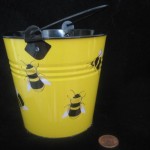[The auction for this Significant Object, with story by William Gibson, has ended. Original price: $2.99. Final price: $101.00]
In 1969 my friend’s dad was a Pentagon technocrat. My friend said that when his dad came home with a new tie-tack, it meant there was a new weapon in the works. Not that there would be a new weapon, but that there was now a coterie of guys in the building who thought the idea was cool enough that they’d wear the tie-tack. It started with the tie-tack. If you couldn’t get the über-geeks to wear your tie-tack, your project wasn’t going to get off the ground. You had to demonstrate that your weapon had fans, and these guys didn’t wear t-shirts. My friend said that Soviet spies should hang out at malls and supermarkets in McLean and take micro-telephoto pictures of tie-tacks. Because it was all there, revealed, this utterly top-secret quadruple-classified shit, on a background of plaid madras. And you could be sure that the weapon of mass destruction depicted there was really the very latest thing, because, he said, it was uncool to wear them once they became a done deal, just as it was uncool to wear them if they definitely weren’t going to happen. What you wanted to demonstrate was that your tie-tack depicted something that was liminal, something still in the Dreamtime.
I imagined that David, my friend’s dad, had one of those ’50s dad boxes on his dresser. Where he kept his doohickeys. Cufflinks. Whatnot. And in David’s box was a fistful of tie-tacks, their little anchor-chains hopelessly tangled, a secret history of Pentagon blue-sky imagination.
He was a good guy, David. In 1969 he told me that what was going to happen with the Soviet Union was that it was going to go bankrupt. He said they were cooking the books, fooling themselves that their economy worked, that their system made sense. He wasn’t talking politics. He was an engineer. He was absolutely right, though I confess I didn’t buy it. I couldn’t imagine a world without the Soviet Union. He called it. The only thing he got wrong was the food riots. In the end, they weren’t necessary. In the meantime, he said, we just had to hold them at bay. With tie-tacks.
This ashtray, I imagine, came from somewhere further along the Hawk missile system’s developmental span. Ashtrays aren’t liminal. When you’re passing out ashtrays, you’ve actually got a product. When they passed a little spring-topped jewelry box, closed, to one of the über-geeks, that confidential “check this shit out” moment, it wasn’t a product, it was a glyph, something there but not there, half-juggled from the Dreamtime.
A fossil from a future that you knew might not even happen. Dashing, enigmatic, unworn. Not yet tangled in the darkness of history’s dad box, with the dead boys and the lost stupid war they died in.







Out of all the objects we’ve found at thrift stores and yard sales for this project, the “Hawk”Ashtray is one of my personal favorites. I came close to keeping it for myself, but I’m glad I didn’t — great story.
Pingback: New Mappings · Future fossils
You know what’s interesting? That weapon looks a lot like a toy I had as a child. The “Mobile Missle System (MMS)” for GI Joe. Of all the toys that came out that year, this was the one I wanted the most. The interesting thing? The figure that came with it was codenamed “Hawk”.
http://www.yojoe.com/vehicles/82/mms/
Wow, this is at $76 already!
Pingback: OBJETOS VALIOSOS EN EBAY « EL VÓRTICE
Pingback: Maud Newton: Blog
Pingback: And the Winners of Six Words on a Significant Object Is… | Not Quite What I Was Blogging
Pingback: Checking in with Significant Objects - Fictionaut Blog
Pingback: Which exposition strategy adds the most value? | Significant Objects
Pingback: Advertising as Art: The ashtray that inspired William Gibson. « NODE
Pingback: Books » Archive » For sale: the ashtray that inspired William Gibson
Pingback: Author Updates | Significant Objects
Pingback: For sale: the ashtray that inspired William Gibson
HAWK is an acronym for “homing all the way killer”. The name has to do with how the HAWK guidance system worked.
Thanks for that info, interesting!
Very interesting project, but I wonder if the buyers of these garage sale objects aren’t purchasing the story by a recognized writer… rather than the object.
We’ve answered that question about writer recognition many times. See the about page or our book for details, but the short answer is that the data does not support the theory that it’s all about the writer’s fame. And we don’t think it’s about “the object,” we think it’s about the story.